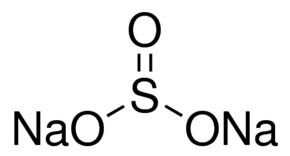Formula Na2SO3 Molar mass 126.043 g/mol Melting point 33.4 °C Appearance white solid | IUPAC ID Sodium sulfite Density 2.63 g/cm³ Soluble in Water | |
 | ||
Related compounds | ||
Sodium sulfite (sodium sulphite) is a soluble sodium salt of sulfurous acid (sulfite) with the chemical formula Na2SO3. It is a product of sulfur dioxide scrubbing, a part of the flue-gas desulfurization process. It is also used as a preservative to prevent dried fruit from discoloring, and for preserving meats, and is used in the same way as sodium thiosulfate to convert elemental halogens to their respective hydrohalic acids, in photography and for reducing chlorine levels in pools.
Contents
Preparation
Sodium sulfite can be prepared in lab by reacting sodium hydroxide solution with sulfur dioxide gas:
2 NaOH + SO2 → Na2SO3 + H2OEvolution of SO2 by adding few drops of concentrated hydrochloric acid will indicate if sodium hydroxide is nearly gone, turned to aqueous sodium sulfite:
Na2SO3 + 2 HCl → 2 NaCl + SO2 + H2OSodium sulfite is made industrially by reacting sulfur dioxide with a solution of sodium carbonate. The initial combination generates sodium bisulfite (NaHSO3), which is converted to the sulfite by reaction with sodium hydroxide or sodium carbonate.
The overall reaction is:
SO2 + Na2CO3 → Na2SO3 + CO2Applications
Sodium sulfite is primarily used in the pulp and paper industry. It is used in water treatment as an oxygen scavenger agent, to treat water being fed to steam boilers to avoid corrosion problems, in the photographic industry to protect developer solutions from oxidation and (as hypo clear solution) to wash fixer (sodium thiosulfate) from film and photo-paper emulsions, in the textile industry as a bleaching, desulfurizing and dechlorinating agent and in the leather trade for the sulfitization of tanning extracts. It is used in the purification of TNT for military use. It is used in chemical manufacturing as a sulfonation and sulfomethylation agent. It is used in the production of sodium thiosulfate. It is used in other applications, including froth flotation of ores, oil recovery, food preservatives, and making dyes.
Reactions
Sodium sulfite forms a bisulfite adduct with aldehydes, and with ketones forms a sulfonic acid. It is used to purify or isolate aldehydes and ketones.
Descriptive chemistry
Sodium sulfite is decomposed by even weak acids, giving up sulfur dioxide gas.
Na2SO3 + 2 H+ → 2 Na+ + H2O + SO2A saturated aqueous solution has pH of ~9. Solutions exposed to air are eventually oxidized to sodium sulfate. If sodium sulfite is allowed to crystallize from aqueous solution at room temperature or below, it does so as a heptahydrate. The heptahydrate crystals effloresce in warm dry air. Heptahydrate crystals also oxidize in air to form the sulfate. The anhydrous form is much more stable against oxidation by air.
